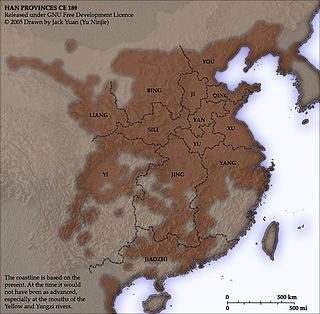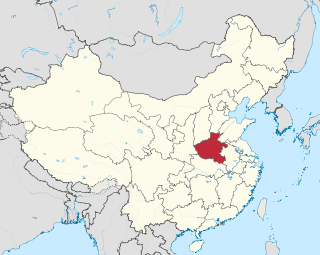
The Warring States period was an era in ancient Chinese history characterized by warfare, as well as bureaucratic and military reforms and consolidation. It followed the Spring and Autumn period and concluded with the Qin wars of conquest that saw the annexation of all other contender states, which ultimately led to the Qin state's victory in 221 BC as the first unified Chinese empire, known as the Qin dynasty. Although different scholars point toward different dates ranging from 481 BC to 403 BC as the true beginning of the Warring States, Sima Qian's choice of 475 BC is the most often cited. The Warring States era also overlaps with the second half of the Eastern Zhou dynasty, though the Chinese sovereign, known as the king of Zhou, ruled merely as a figurehead and served as a backdrop against the machinations of the warring states.
A jùn was a historical administrative division of China from the Zhou dynasty until the early Tang. It is usually translated as a commandery or a prefecture in different eras of Chinese history.
The history of the administrative divisions of the Imperial China is quite complex. Across history, what is called 'China' has taken many shapes, and many political organizations. For various reasons, both the borders and names of political divisions have changed—sometimes to follow topography, sometimes to weaken former states by dividing them, and sometimes to realize a philosophical or historical ideal. For recent times, the number of recorded tiny changes is quite large; by contrast, the lack of clear, trustworthy data for ancient times forces historians and geographers to draw approximate borders for respective divisions. But thanks to imperial records and geographic descriptions, political divisions may often be redrawn with some precision. Natural changes, such as changes in a river's course, or loss of data, still make this issue difficult for ancient times.

Changzhi is a prefecture-level city in the southeast of Shanxi Province, China, bordering the provinces of Hebei and Henan to the northeast and east, respectively. Historically, the city was one of the 36 administrative areas extant under the reign of the first emperor of a unified China.

The Seven Warring States or Seven Kingdoms refers to the seven leading states during the Warring States period of ancient China:
Yanjing was an ancient city and capital of the State of Yan in northern China. It was located in modern Beijing.

You Prefecture or Province, also known by its Chinese name Youzhou, was a prefecture (zhou) in northern China during its imperial era.
Yuzhou or Yu Province was one of the Nine Provinces of ancient China, later to become an administrative division around the reign of Emperor Wu of the Western Han dynasty.

The Sixteen Kingdoms, less commonly the Sixteen States, was a chaotic period in Chinese history from AD 304 to 439, when the political order of northern China fractured into a series of short-lived sovereign states, most of which were founded by the "Five Barbarians," ethnic minority peoples who had settled in northern China during the preceding centuries and participated in the overthrow of the Western Jin dynasty in the early 4th century. The kingdoms founded by ethnic Xiongnu, Xianbei, Di, Jie, Qiang, as well as Han Chinese and other ethnicities, fought against each other and the Eastern Jin dynasty, which succeeded the Western Jin and ruled southern China. The period ended with the unification of northern China in the early 5th century by the Northern Wei, a dynasty that evolved from a kingdom founded by ethnic Xianbei.

She County, or Shexian, is a county of southwestern Hebei province, China, located on the lower reaches of the Zhang River and bordering Shanxi to the west and Henan to the south. It is under the administration of the Handan City, with a population of 400,000 residing in an area of 1,509 km2 (583 sq mi).
Lu Yanhong was a warlord of late Tang dynasty China, who controlled Shannan West Circuit from 883 to 884 and Zhongwu Circuit from 884 to 886.
Jingzhou or Jing Province was one of the Nine Provinces of ancient China referenced in Chinese historical texts such as the Tribute of Yu, Erya and Rites of Zhou. It became an administrative division during the reign of Emperor Wu in the Western Han dynasty.
Ji or Jicheng was an ancient city in northern China, which has become the longest continuously inhabited section of modern Beijing. Historical mention of Ji dates to the founding of the Zhou Dynasty in about 1045 BC. Archaeological finds in southwestern Beijing where Ji was believed to be located date to the Spring and Autumn period. The city of Ji served as the capital of the ancient states of Ji and Yan until the unification of China by the Qin Dynasty in 221 BC. Thereafter, the city was a prefectural capital for Youzhou through the Han Dynasty, Three Kingdoms, Western Jin Dynasty, Sixteen Kingdoms, Northern Dynasties, and Sui Dynasty. With the creation of a Jizhou (蓟州) during the Tang Dynasty in what is now Tianjin Municipality, the city of Ji took on the name Youzhou. Youzhou was one of the Sixteen Prefectures ceded to the Khitans during the Five Dynasties. The city then became the southern capital of the Liao Dynasty and then main capital of the Jin Dynasty (1115-1234). In the 13th Century, Kublai Khan built a new capital city for the Yuan Dynasty adjacent to Ji to the north. The old city of Ji became a suburb to Dadu. In the Ming Dynasty, the old and new cities were merged by Beijing's Ming-era city wall.
Yangzhou, Yangchow or Yang Province was one of the Nine Provinces of ancient China mentioned in historical texts such as the Tribute of Yu, Erya and Rites of Zhou.
Xuzhou as a historical toponym refers to varied area in different eras.
Zhao Dejun (趙德鈞), né Zhao Xingshi (趙行實), known as Li Shaobin (李紹斌) during the reign of Li Cunxu, formally the Prince of Beiping (北平王), was a general of the Chinese Five Dynasties and Ten Kingdoms period state Later Tang. Toward the end of Later Tang, he was ordered by Later Tang's final emperor Li Congke to combat Li Congke's brother-in-law, Shi Jingtang, who had rebelled against Li Congke's reign and established his own Later Jin, as well as Shi's Khitan allies, led by Khitan's Emperor Taizong. However, after failed negotiations in which Zhao himself tried to get Emperor Taizong's support to overthrow Later Tang, the joint Khitan/Later Jin forces defeated him, forcing him to surrender to Khitan. He died in captivity.
Longxi Commandery was a commandery of imperial China in present-day Gansu.

Yong Province or Yongzhou was the name of various regions and provinces in ancient China, usually around the Wei River or the imperial capital.
Kuaiji Commandery, formerly romanized as K‘uai-chi Commandery, was a former commandery of China in the area of Hangzhou Bay. When first established, its capital was at Wu, which became known as "Kuaiji" from this role. The initial territory ran from the south bank of the Yangtze through most of modern Zhejiang to an indeterminate border among the free people of Minyue. Wu and Wuxing commanderies were later formed between the Yangtze and the north shore of Hangzhou Bay; the administration of the remainder of Kuaiji Commandery was then removed to the site of the former Yue capital in modern Shaoxing's Yuecheng District, which also became known as Kuaiji from this role. By the Tang, Hangzhou was also separated and Kuaiji ran from a little north of the Zhe River in the west to Ningbo in the east.















